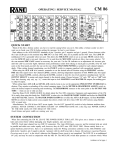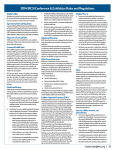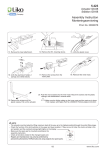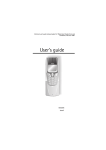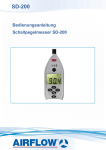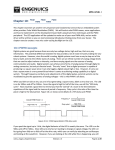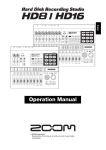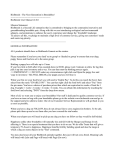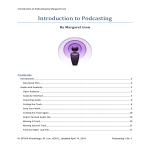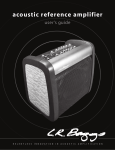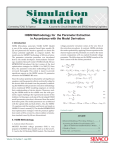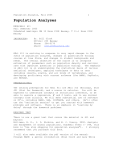Download Church Sound Survival Guide
Transcript
the Church Sound Sur vival Guide 1 Chu rc h Sound l a v i v r u S G u ide What you need to know to Run Church Sound SG001 Bob Kilpatrick Church Sound Sur vival Guide 2 The Church Sound Su rvival Guide What Yo u Need To Know To Ru n Chu rch Sou nd by Bob Kilpatrick A step by step explanation -in plain Englishof the parts of your sound system, what they do and how to work with them. © 2004 Bob Kilpatrick Ministries, Inc. Copying this material is both illegal and immoral. Copy our address instead; Bob Kilpatrick Ministries, P.O.Box 2383, Fair Oaks, CA 95628 Chapters 1- A Bird's Eye View Of Your Sound System 2- Speakers & Power Amps & Monitors- Oh, My! 3- Testing...Testing...Is This Thing On?! (mics & instruments) 4- Apollo to Earth. We Have Lift-Off. (the mixer) 5- Once Is Enough (the gain knob) 6- How To Make Everybody In Church Hate You (the EQ controls) 7- Daddy, Why Does The Preacher Sound Like God? (effects) 8- When She Thinks She Can Sing (pan, solo & mute) 9- And Then We Put It All In A Bowl... (basic mixing) 10- Elephants In The Pews (feedback) 11- When All Else Fails (troubleshooting) Church Sound Sur vival Guide 3 Church Sound Sur vival Guide 4 Chapter One A Bird's Eye View Of Your Sound System If a bird, with its limited intelligence and simple thought process, flew over your church building after the roof had been blown off, here's how he would see your sound system-Instruments -Mixing Console -Speakers. And really, that little bird has it right. There are only three aspects to your sound system, as simple or complex, big or small, as it may be. There are the parts that MAKE noise; there are the parts that MIX the noise together and effect (change) it; there are the parts that BROADCAST the noise. The parts that make the noise- the microphones, instruments, CD players, 8tracks- have to get IN to the mixer. The mixer mixes them together in some (hopefully) pleasing combination. The mixer sends this combined sound OUT to the parts that make it loud- the power amplifiers and speakers- and they broadcast it to the world... or at least to the tenth row. On the next page there is a diagram of a sound system. Remember, no matter how complex a system is, it still just has these three parts. And remember this, too; it works on the flow of electricity. Every microphone and instrument has some sort of wire connecting it to the mixer, as do the speakers, effects units and every other device. Even the wireless units will eventually plug in via wired cables. It pays to respect this fact. It also helps to transition to a metaphor I find useful in describing how sound works. Sound systems are like sprinkler systems. Just as the water flows into the heart of a sprinkler system and is sent to various watering stations, so your sound is flowing into the mixing console and will then be sent in various directions. Just as the water eventually comes out a sprinkler and is broadcast over the yard, so your sound must eventually end up somewhere- coming out a speaker, going on to tape, feeding headphones, etc. So, how does the sound from the noise-makers get into the console? There are many kinds of connectors- Cannon (XLR), phone jack, mini-phone jack, RCA, Elko, banana plugs, USB, light-pipe, firewire- but the two most common are Cannon (XLR) and phone jack connectors. I don't know why they're called Cannon plugs. Maybe it's because Church Sound Sur vival Guide 5 The Whole System IN OUT & Back IN Effects Mixing Console OUT Power Amplifier Power Amplifier Main Speakers Monitor Speakers Church Sound Sur vival Guide 6 they're large, round and look like small cannons. I do know, however, that XLR stands for ground (X), left (L) and right (R). Cannon plugs look like this while phone jacks/guitar this. cables look like Most microphones will use an XLR, while most instruments use a phone jack/guitar cable. There is a difference in the impedance at which they function, but I have no idea how to explain that in technical- or even layman's- terms. Let's see... XLR cables are low impedance (low Z), which means that they offer little resistance to the signal as it moves down the wire. Phone jacks are high impedance (high Z), which means they offer a lot of resistance to the signal. (For more information on this subject, ask a tech-nerd.) The real world application is that you can use XLR cables for long distance runs, but you can't do the same with guitar cables. Because the console is generally further away from the stage than you can run a guitar cable, you need a way to drop the impedance of the signal and make it able to get to the console without losing the purity of its sound. Enter the DI (direct injection), better known as a Direct Box. A typical direct box looks like these examples (my fave- the LRBaggs ParaAcoustic DI. Can't be beat for guitar and most other instruments, and they make a bass model, too.) The purpose of the direct box is to get the signal strength of your instrument up and to the console sounding real good. Advice: try to resist using cheap direct boxes- sometimes called line transformersbought at a shack that mainly deals in radios. Many times, the temptation to save a few dollars will cost you in the quality of your sound and the reliability of the product. Buy good stuff. Church Sound Sur vival Guide 7 In a normal church system, there will be a snake between the stage and the console. There is no need to fast and pray. You want this snake there. This is the highly technical term for a bundled bunch of cables with various sorts of connectors at each end. Sometimes these are installed in the stage/platform, so you'll never see the snake itself. In many churches, especially the ones that meet in rented facilities and must set-up and tear-down for each service, the snake is laid out on the floor for all to see. It will look something like this. This is only a way to get your cables on the stage- and sometimes your speakers- connected to the console. Generally, you want to convert all your signal from high to low impedance at the stage, before it goes into the snake. The cable ends (connectors) on the snake will each be assigned a number or letter. These correspond to the numbers and letters at the other end of the snake (surprised?) This is what we call organization. The simplest, most fool proof system of organization is to plug cable "1" into channel "1" on your mixer, cable "2" into channel "2" and so forth. If you come up with a better approach, please contact me. Advice: invest in a cable tester. These are inexpensive and will help you easily find out if a cable is working or not. It just makes sense. Advice: if you're experiencing difficulties in your sound, start with the simplest, most convenient possible solution and work toward the most complex and least convenient. Again, it just makes sense. Make sure everything is powered up and volume is up first. Next check your console settings. Then check your connections. Then check your cables. Crawl around under the stage after that. The Mixing Console goes by various names; soundboard, board, mixer, console, mixing desk, desk, "you stupid thing!", etc. We'll just refer to it as the mixer. It is called a mixer because it takes all the individual elements that will make up your overall sound and mixes them together into one (mono) or two (stereo) sends. It will generally have the ability to shape the sound through equalization and effects, and it will generally have the ability to send sound to various places, ie., to main speakers, monitors, a tape deck, the mother's cry room. This is where the noisemakers and the broadcasters meet. You've got your noisemakers plugged in. Let's move on to the power amps and speakers. Unless it has a built in amplifier, a mixer puts out an unpowered signal from its speaker or main outputs. Hence, the need for a power amplifier. Be careful not to send a powered signal to a power amp. Crazy things can happen. The good news is that if crazy things happen once, they probably won't happen again; you'll have fried your amps or speakers. The bad news is that this can be an expensive lesson. On the back of the mixer there will be one or two outputs marked "Mains," "Main Church Sound Sur vival Guide 8 1 & 2," "Speaker Left & Right" or simply "1 & 2" or "Left & Right." These should be sent to your power amplifiers and on to your main speakers, sometimes called house speakers or mains. Many new speakers have power amps built in. These are called "self-powered" speakers. For small to mid-sized systems, these make good sense and sound great. Either way, though, your signal is first going to a power amp and then out the speakers. The same will be true of your on-stage monitor speakers. Mixer- power amp- speakers, in that order. When connecting all these parts, it's a good idea to have the electrical power off and the volume levels everywhere all the way down. Bring the volume levels on the power amps (or the back of the speaker cabinets, if they are self-powered) up before you bring up the volume on the mixer. I'd also suggest playing a CD through the system first before turning up mics and instruments. This will allow you to get an idea of the relative volume without injuring anyones ears. Your on-stage monitoring system can be comprised of speakers, in-ear phones or a combination of the two. Either way, as with the main outputs, the mixer will send an unpowered signal, so you'll need to power that to the speakers or headphones. Warning!: headphones and speakers don't take the same amount of power! Use a headphone amp for headphones. On the back of the mixer, you'll find outputs marked "Aux 1," "Monitor 1" or something like that. "Aux" simply stands for auxiliary, meaning it's an additional output. There is no mystery to this. Remember, it's like a sprinkler system, helping you to get flow to various stations. The volume to the monitors will be somewhat independent of your inputs and (hopefully) completely independent of your main outputs. You should be able to turn down your main speakers and still hear the monitors. Try this with a CD player. We'll talk more about this in the chapter about Aux sends. You may be using an external effects unit (It's called external because it's not inside your mixer.) If so, you'll need to send signal out to it and back in to the mixer so you can combine the sound it makes with all the other sounds. This creates what is called an effects loop, simply because it loops out and back in again. On the back of your mixer there may be an output specifically marked as "effects send." I'll tell you a secret; this is, in almost every case, just an Aux send with another name. There's nothing special about it. The manufacturer is trying to helpfully guide you. You could use this output to send signal anywhere you wanted. If there isn't a specially marked output for effects, use one of the Aux sends. If your mixer has more than two Aux sends, find the ones that are "Post" (more about this later) and use one or two of them for your effects loop. Church Sound Sur vival Guide 9 Chapter Two Speakers & Power Amps & Monitors- Oh, My! Sound is traveling through your cables in one direction- from the noisemakers, to the mixer, through it to the power amps and out to the speakers. When connecting your gear, "Input" means that's where the sound comes in to this piece of gear. Conversely, "Output" is where it will leave and travel on. Whatever signal you send through a cable will appear at the other end of that cable. This sounds rudimentary, but I'm surprised at the number of sound folks who think that they can send a main mix AND a monitor mix through the same cable to the same power amp and expect each of them to be different coming out the speakers. They can't, unless you're using a stereo cable, which is really two cables in one sheath. You will need one amp for mains and another for monitors. Let me explain something about "mono" and "stereo" at this point. "Mono" is, of course, one signal. "Stereo" is simply two monos traveling through a system, or down a cable that has two different wires carrying two different signals. Even though you can make them sound very much alike, they're still two mono signals with completely discreet paths. Some power amps are stereo, meaning that they have two separate mono amps at work powering two different signals. This means that you can use each of the two independently of each other. If you like, you can run your mains out the left side and your monitors out the right side. Even though they may be marked "Left" or "Right," this is, again, the manufacturer trying to provide a helpful guide. There is nothing uniquely left or right about them. They're both mono channels through which your noise can pass through to the speakers. They are completely separate power amps in one housing. If you can, however, you should have two different power amps for your mains and monitors. Again, they can't share a power amp, otherwise they'll produce the same mix of sounds. You'd like the monitors to be independent of your main mix for a variety of reasons. Here are some; - Your guitar player is deaf and likes his instrument very loud in the monitors. - You are playing a track for the choir to sing with. - You are sending a "click track" (timing metronome) to the drummer that you don't want heard by the audience. - You want a way to talk with the performers during the performance without being heard by the audience. - You are trying to make a tone deaf diva wannabee sound good by letting the track drown her out in the mains without her knowing it. Church Sound Sur vival Guide 10 In the section on the channel module we'll be talking more about the Aux sends, but let me say at this point that your mixer is capable of producing completely different mixes through the various outputs it has- main, monitor, Aux, effects, etc. Just like your sprinkler system, the flow is sent in a certain direction and is handled differently at each station. Your monitor mix should be completely different from your main mix. If you are using an Aux send for your monitors, each little volume knob on each channel strip is helping you create a unique mix just for the monitors. More about this later. When connecting your mixer to your power amp and your power amp to your speakers, be sure that you are plugging the right cable into the right input. With some of the new self-powered speakers, there are multiple inputs on the back of the speaker housing. In one recent incident, a sound man plugged his main outputs from his mixer into the wrong input of his self-powered speakers. He blew them up. His confusion was primarily brought on by the introduction of a new kind of input connector that he didn't recognize. It's called a Neutrik connector and looks like this. It's a cool design because it will accept either XLR or phone jacks in the same connector. My sound man friend had never seen this before and didn't read the words by the other connector or didn't think that it was important. It is important. Make sure your connections are right before you power things up. Your mixer should be sending a "line level" signal, different than a "mic level" signal. Match them up properly to protect your gear. There are many opinions about where to place your main speakers. You can group them in the center or spread them out to the far sides, or have an array of speakers that goes all the way across the stage. Do what works for your building. The only common practise in all of these approaches is that the speakers should be above the heads of the audience and the manufacturers name should be right side up. This is the manufacturers way of showing you which way their speakers are meant to work best. If you turn your speakers on their sides, you'll compromise the sound. Speakers are made to have a dispersion pattern. That is, how wide and how high and low the sound will go from the speaker. Let's talk sprinklers again. You can have one that sprays water in a half circle out about ten feet. If you were to turn that sprinkler head on its side, you'd have a narrow, vertical strip of water spraying straight up, out and straight down. You'd miss all the grass on the sides. Speakers disperse sound in the same way. A speaker on its side will have a very narrow hot spot directly in front of it and will not throw the sound out to the sides. Instead, you'll be losing much of your sound upward and downward. Be sure to place them properly for maximum coverage and efficiency. Church Sound Sur vival Guide 11 When your main speakers are not elevated above the audience, you are losing a lot of your sound in the people closest to the speakers. Bodies are marvelously sound absorptive. The first row will get blasted while you try to raise the volume to throw to the back of the room. Solution; raise your speakers. Put them on speaker stands if you can. You'll get a surprising rise in volume, coverage and clarity from this simple move. Placing monitor speakers is a bit more complex, partly because of their proximity to the microphones, partly because of the needs of the performers and partly because of the aesthetic look of the stage that is desired. Probably the most important first concern is to face your monitor speakers away from the audience. This will reduce the effect they have on your main mix. Because different frequencies travel in different patterns, your monitor placement can have a significant, and mostly negative, effect on the sound in the auditorium, especially a small auditorium or room. Higher frequencies travel in a straighter, narrower line while lower frequencies tend to go everywhere. If you stand behind a speaker, you'll notice that you hear loads of bass rumble and not a lot of the high-hat. It's not a clear sound. Well, your audience is behind all your monitor speakers and they're hearing the low end rumble without the clarity of the higher frequencies, too. I've known many sound people who were frustrated because their main mixes were muddy. They tried to boost the high frequencies to get clarity and instead got brittleness. Most of the time, they were not taking into consideration the effect the monitors were having. There are several ways to mitigate this effect. - If you move your monitors closer to your performers, you can reduce the volume level on stage. - On the other hand, you can raise your main speaker volume level to over-ride the monitors. - You can also use sound dampening materials on the back of your stage or platform. This will reduce the mid and high frequencies but will have little effect on the low rumble coming from the monitors. - You can reduce the level of the low frequencies going to your monitors. I prefer a combination of the above approaches. I'd suggest moving the monitors closer while also dropping some of the lows out of them. Because I like loud monitors when I perform, I shy away from suggesting that you turn them down. There is another way to completely do away with this problem: use in-ear monitors. Most churches will not do this because the standard in-ear system is very expensive. I have used another in-ear approach that is not only inexpensive, but works very well for church sound and worship team applications. On the next page is a simple diagram of how it works. I'll also describe it. My band and I used this approach when we recorded a live CD and we were all quite satisfied with the sound. You'll need the following gear to make this happen: Church Sound Sur vival Guide 12 - headphone amp- preferably one with six or more stereo headphone outputs, each with its own volume control. Loads of companies make these, among them Furman, Behringer and Rane. You'll need as many of these amps as it takes to provide for all your musicians (six musicians= one amp, in our example.) You can send two different mixes to two different headphone amps and give your rhythm section one mix while sending the other to your vocalists. - stereo extension cables- these have a male end and a female end. You'll need one for every headphone output. - stereo phonejack to mini-phonejack adaptor- this simply allows you to plug in virtually any set of mini-phonejack earbuds to the extension cables. - cheap earbud headphones- the kind you'd use for a portable CD player. You can pick these up at any electronics store. Voila! We have meatloaf! Put your headphone amp on the stage somewhere, accessible to as many of the performers as possible. That way, they can easily adjust their own volume. Run your extension cables to the various positions of the performers. I'd suggest taping them (the extension cables, not the worship team) to a mic stand, keyboard rack or drum stool. Our bass player bundled his with his guitar cable so it ran alongside it. Each performer wears their earbuds on to the stage (running the cables under their clothes so they are less obvious.) When they get to their position, they plug into the adaptor on the end of the extension cable. When they're done leading worship, they unplug and walk off. Simple and inexpensive. This whole approach, with two headphone amps, will cost you less than $1,000. If your worship leader plays guitar, he can bundle his extension cable with his guitar cable like our bassist and be as mobile as he ever was. You can also consider having a couple of on-stage monitor wedges to fill in when someone is on stage without earbuds. Church Sound Sur vival Guide 13 Wired In-Ear System 20'-30' stereo extension cables headphone amp line level, unpowered send to headphone amp Church Sound Sur vival Guide 14 Chapter Three Testing...Testing...Is This Thing On?! (mics & instruments) There are so many different types of microphones! And you hear so many different terms for them- condenser, dynamic, capacitor, electret, piezo, cardioid, omni... it can be confusing and intimidating. Let's try to sort some of this out in a decidedly nonprofessional, real-life way. At bottom, there are two kinds of microphones- dynamic and condenser. Condenser and capacitor mics are one and the same. Here in the US we call them condensers; in the UK they call them capacitors. The same is true of tubes and valves. What we call a tube mic or tube amp, the Brits call a valve mic or valve amp. The basic difference between the dynamic and condenser mics is the way they convert sound into an electrical signal. The way they are constructed to accomplish this produces characteristics that are predictable to each. Dynamic mics tend to handle high frequencies less well as condensers but tend to be tougher and handle loud volumes better. Condensers tend to reproduce the highs better and are a bit more true to the source sound. They are more expensive and more fragile, too. Dynamics tend to have what's called "proximity effect," which is the boominess you hear when you sing closer to the mic. As I understand, this is due to the physics of the design, but all I know is I can sound like Barry White if I want to. Proximity effect can be useful when using a dynamic mic on a guitar or bass cabinet. Putting it very close to the speaker cone will give a punchier sound. It can also help some singers get the sound they're looking for. Condenser mics need a power source in order to work. Some come with batteries while others rely on an external power source. Years ago, someone came up with the idea of sending the power through one of the three wires in an XLR cable. This power is 48 volts and is called "phantom power." It's called that because you can't see the power source at the microphone. It's like a ghost, but a good ghost. You'll probably see a button on your mixer that is labeled "phantom power" or "48v" or some variation of these. This button enables or disables the phantom power flowing through the microphone cables. Some mixers have a button on each channel, some have it in channel groups of eight while some have one button for all channels. Advice: if you don't need phantom power to any of your microphones or instruments, turn it off. The less electricity flowing around, the better. Church Sound Sur vival Guide 15 Many times, a sound person will be frustrated by the lack of any signal from a microphone and will blame it on the cable, the connection, the musician or God. It might be wise to avoid the lightning strike and check first to see if the mic requires phantom power. Microphones have pickup patterns; that is, areas in proximity to the mic where the sound is louder and better and areas where it is softer and worse. There are three basic patterns, one of which, the "figure eight," is so rarely used that I'm not going to discuss it. You can find plenty of information about it on the internet. The other two patterns are omin-directional and cardioid. Omni being the prefix for "everywhere" or "in all directions," it's pretty obvious that this means that an omni mic has no sweet spot but picks up sound from all directions equally. This sounds like the optimum sort of mic, doesn't it? Except that sometimes you have mics close together and you'd like the one on the violin not to pick up the sound of the didgeridoo. This is where a cardioid mic comes in handy. Because of their pick-up pattern, cardioid mics tend to reject sound from "off-axis" (right in back of the mic.) Here is a mic (1.) with the pickup pattern shown. The other illustration (2.) is a graph of the pattern without the microphone. If you turn it over (3.), it looks like a heart, hence the term cardioid, Latin for "heart-shaped." 1. 2. 3. Cardioid mics work better in situations where you need to isolate the primary sound and where you need off-axis rejection of other sounds, most notably the monitors. Condenser mics and omni mics will feed back much earlier than a cardioid dynamic mic will. For these reasons, dynamic cardioids should be your mic of choice for live sound, especially for your vocalists. If you're having trouble with feedback all the time, check to see what pattern your vocalists' mics are. There are many different dynamic microphones you can buy, and they tend to be fairly inexpensive, in the $80-$200 range. Shure SM-58s are the standard workhorse, but I prefer the Audix line of OM mics. They're in the same price range but handle high frequencies better and have less proximity effect. My personal favorite- the one I use in concert- is the OM6, but you can't go wrong with any of this line of mics. One more thing about them, they have the strongest rejection of feedback I've ever experienced. It's difficult to get them to squeal! We've already discussed plugging your instruments into a direct box and getting the signal to the board. Let's talk about some general rules of thumb that will help make your sound clear. Each musician that is sending you a direct signal should give you his strongest output from his instrument. Turn it all the way up. Some like to reserve a little for them- selves in case they want to turn up during their set. This is counter-productive to your goal, mainly because it changes the input level on that channel which changes the volume send levels everywhere down the line- mains, EQs, Aux sends, monitors- everything. If you're not expecting it, it can play havoc with what was a good mix. Church Sound Sur vival Guide 16 Another reason for getting their strongest signal is what is called "signal to noise ratio," sometimes noted as "S/N." This is a very important piece of knowledge and will come in handy later in the book. I'm going to define it now, but remember it later when we talk about the gain knob. Every piece of equipment in your system produces noise. The instruments do, the reverb unit does, the mixer, the power amps, the speakers themselves. How much noise each produces is unique to itself. This amount of inherent noise is called the "noise floor." You can't change this. You can't get rid of it, but you can fight it. You can even reduce it in a way. Here's how. In diagram #1 to the right you see the supposed noise floor of a guitar. For our example, let's say it's 10 Db. Don't let the Db scare you. It's not the terminology that matters at this point, it's the numbers and their relationships. Let's say the guitar's noise floor is 10 lemons. Let's say the guitar player is only giving you a very low output level of 20 lemons. This creates the signal to noise ratio. What that means for you is that half of his signal is noise. When you raise his level so that he can be heard, you're raising not only the signal he intended to give you but the noise floor as well. In diagram #2, we've raised his level to 40 lemons. Consequently, the noise floor has risen to 20 lemons. 20 bad lemons! Here's where it gets interesting. Let's say the guitar player is ashamed for giving you such a low signal, repents, changes his ways and boosts his output level all the way to 11, which gives you a level of 100 lemons. The inherent noise of the instrument does not go up. It's the noise floor of his instrument or piece of gear, remember, but NOT the noise floor of your input. Now the diagram (#3, Church Sound Sur vival Guide 17 previous page) looks like this. Okay, but we still only need 40 lemons of level from him, so we're going to bring the input on the mixer down. His noise floor goes down, too! How cool is that! So, because your guitar player did the right thing and gave you everything he's got, his signal is VERY much cleaner (diagram #4, previous page), your sound is better and the congregation has a higher worship experience. See what a little twist of a knob can do?! Good lemons! The rule of getting high levels applies to keyboards and bass as well. The stronger the signal from the instrument, the better everyone will sound. Let's talk about keyboards for a bit. Unless you're doing a stereo mix in the main speakers, it is not necessary to receive a stereo feed from electronic keyboards. Of course, you can if you want, or if you have 144 channels and don't know what to do with them all, or if the keyboard player is the pastor's wife. These are all good reasons to have a stereo feed from the keyboard. If none of these is true, though, and you're fighting a limited number of available channels, I'd cut the keys to mono (I'd also group background worship team vocalists around one or two mics instead of letting each of them have their own mic, but that's a later discussion.) You might also try to talk your keyboardist into experimenting with some sounds other than the stock "piano with crappy strings" patch or the "electric piano that reminds us all of Richard Marx" patch. Yes, I'm being snide, but there's a method here. Keyboards, guitars, vocals, sax, horns, organ and any other melodic instruments are all crowding your space between 125 and 800 hertz. This may not mean much to youand your eyes are starting to glaze over- but this is the reason for most muddy mixes. There's just too much going on in the same frequency range. Getting crisper sounds out of everybody will clean up a mix in a hurry. So ask your keyboardist to try something else, like those bell tones everyone loved in the 80s. Sometimes bassists and guitarists insist that their tone is wholly and completely dependent on the sound of their cabinet, so they insist that you mic their cabinet. Hmmm... how can I put this politely... if their tone is from their cabinet, ask them to stand their guitar and cabinet on the platform for the worship service and enjoy the service themselves from the front pew. If it's not their fingers and hands that give them "their" sound, they should sell their instrument and become an usher. I recorded an album in the late 80s and had the pleasure of having Chris Hayes, lead guitarist and songwriter for "Huey Lewis & the News" play on the project. He brought two guitars and an amp into the studio. The amp promptly blew up. We scrounged up another replacement amp for him and he plugged in. The engineer, Steve Counter, asked Chris if he had any favorite settings to get his sound. Chris replied that Steve should do whatever sounded good to him, so that's what Steve did. Chris played on three songs and there is no mistaking who it is. His sound was not dependent on his amp, cabinet or settings. It was in his fingers. Church Sound Sur vival Guide 18 In a live setting, the sound the audience hears is not the same sound the players hear. For most purposes, I prefer that the guitarist and bassist go direct into the mixer. If they like, they can step out into the room and help to tweak the sound in the mains. However, that sound, too, will change depending on where one is in the auditorium. It's a fascinating game, this search for tone, but you will gain more control and cleaner signal if they go direct. Okay, enough meddling. No, wait! We left out the vocalists. I have to be an equal opportunity meddler here. As I mentioned earlier in this chapter, my preference would be to group the backing vocalists around a mic or two. This will not only make your job easier, it'll improve the blend of their voices. You can have a mic set aside for solos, if any of them need to step up and sing one. Advice: Pay attention to the stage from start to finish. Don't let friends come to the mixer and engage you in conversation. Don't be making a count of the number of people in attendance this Sunday. Let one of the ushers do that. Pay attention to the responsibility before you. That way, when a backing vocalist does step up to sing a solo, you'll be there to give them good sound. Microphone etiquette demands that vocalists not puff into their mics. Besides being an unpleasant sound, this sends moisture onto the diaphragm and can junk up a perfectly good microphone in no time. If you need to check if a mic is on, the best way is to tap it with your wedding ring. If you're not married, use a promise ring or an ankle bracelet. Any metal lightly tapped on the grill of a mic makes a very strong, clear sound and doesn't hurt the mic. The same etiquette asks vocalists not to dangle their mics down toward the monitors. They'll get a lot of attention this way, but probably not the kind they want. That's it for the band. Let's move on to the mixer itself. Houston, we have a problem... Church Sound Sur vival Guide 19 Chapter Four Apollo to Earth. We Have Lift-Off. (the mixer) Now we're getting to the really important stuff. This is the heart of the matterthe heart of the system- where things go really right or really wrong. This is the piece of gear that you will have the most tactile contact with. It's a big subject. Let's go. There is a diagram on the following page of a channel strip. We're going to go through it step by step, starting with the knob that's furthest away from you- the gain knob- and working toward the control that's closest to you- the fader. What I am going to describe is a generic board that does not exist. It is only in my dreams. Your mixer will differ from this one. There are knobs and buttons on your mixer that I won't mention. That's what an owner's manual is for. I'm going to attempt to cover the most important parts of a mixer and give you a better real-life understanding of the effect each control has. I have chosen to describe a channel strip because, unless you have a very sophisticated or very odd mixer, one channel strip on your board will be just like all the other channel strips. If you know one, you know them all. A mixer can be intimidating because of all the rows of button, knobs and faders. Breaking it down to a channel strip will help clear the fog and dispel the fear. A mixer is laid out in a logical, ergonomic way. The reason, for example, that the gain knob is the top one, closest to the actual input connector, is because it is the door to the mixer through which a signal must pass. Based on that, a second reason is that the manufacturer is trying to create the shortest signal path through the mixer that he can. Another reason that that particular knob is furthest away from you is because it is the knob you should adjust the least. The fader is the one you should adjust most. That's why it's so easy to reach. More on this later. Here is a fact that you may not have considered; every control on your mixerother than the buttons- is a volume control. This is not a joke. Each and every knob controls the amount of level being sent somewhere. Like a valve on your sprinkler system, the more you open it up, the more signal gets through. "Aha!" you may say, "what about the PAN?!" As you will see later, even that is a volume control. In the diagram on the next page, all the round objects are knobs that you turn for a variable effect on the signal. All the small rectangles with rounded corners are buttons you push for an "on/off" effect. The gain knob- this control goes by various names; attenuator, input level, gain, Church Sound Sur vival Guide 20 4 Pre or Post4 Pre or Post4 Low Shelf 4 Mute4 Solo 3High EQ (Equalization) 3Mid EQ 3Low EQ 3Aux Send 1 (Pre or Pre-or-Post) 3Aux Send 2 (Pre or Pre-or-Post) 3Aux Send 3 Pre 3Aux Send 4 Pre 3Aux Send 5 Pre 3Aux Send 6 Pre 3Pan 3Fader The Channel Strip 3Input, Gain, Attenuation, Pad Church Sound Sur vival Guide 21 pad. Whatever the name, this is, as I said, the entry way for the signal into the channel strip. High EQ- EQ stands for equalization. It's an old term meaning that this control, as is also true of the mid and low EQ controls, is for evening out- equalizing- the tone of the signal. This boosts or cuts the high frequencies; that is, increases or decreases the level sent to that frequency. Mid EQ- does the same thing High EQ does, only for the mid-range frequencies. Low EQ- boosts or cuts the lowest range. Low Shelf- this button engages or disengages what's called a low end roll-off, or low cut. It will generally reduce the volume steeply of any signal in the range below 75100 hz. Advice: I cut EVERYTHING below 100-125 hz except the bass. There are few useful tones for human ears in that range. There are loads of overtones that can cause distorion or muddy sound in other frequencies. When I started doing this, I noticed an immediate greater clarity in my mixes. Aux Sends 1-6- This simply means that these are auxiliary- extra or additionalsends. They are used to create an entirely independent mix of the signals. You'll notice that some of these are marked Pre, some are Post and some are switchable between Pre and Post. You may ask yourself "What in the world does THAT mean?!" I am here to answer that question. Of course, you already know that Pre means before and Post means after, but before and after what?- Before or after the channel fader. Pre-sends tap into the path of the signal before it reachs the fader; post-sends tap into the signal path after the fader. Any Aux send that is Pre will still continue to carry signal even when the fader is down. In fact, no fader moves will affect this level at all. Any Aux send that is Post will change in relation to the fader. If the fader comes down, so will all the Post sends. Solo button- This doesn't necessarily mute all other sounds except the one coming through this channel when engaged. It's primary purpose is to solo the level of that channel input to your Db meters (those green, yellow and red lights up in the top right hand corner of the mixer that bounce around so much while the band is playing.) This is so you can see if your input level, controlled by your gain knob, is too low, too high or just right. You should use this on every channel during the sound check. Ask each musician to make noise one by one at full volume. This gives you a fairly accurate way of setting your input level. When no channel is soloed, the meters are generally measuring the master output. But when you press the solo button, the meters immediately change function and begin to measure the input level of that specific channel. This is very important. Make sure you understand this point. It will help you every time you get started on a mix. On a recording session, the first thing we do is to set the input level. This is foundational. If your foundation is built on sand, collapse will your house (in non-Yoda, your sound will be bad.) Church Sound Sur vival Guide 22 The Mute button- this mutes the signal coming through the channel. You won't hear it anymore. Some mixer mute buttons affect the entire channel strip, meaning that they mute the EQs, the Aux and effects sends as well as the mains. Others only mute the main outputs. You should know which way your mixer does things. Otherwise, you may mute a guitar player (like me) sometime and when he unplugs his guitar, it will make a nice, attention-getting thwack in the monitors. This is not good for winning friends. The Fader- this reduces or increases the level on the channel to the main speakers and any controls that are set to Post fader. "What about that extra button just left of the mid EQ knob?" you ask. Some mixers have a sweepable mid-range EQ control that you can engage or disengage. Consult your manual for this one. I don't want to talk about it. That wasn't so hard, was it? Now that you know one channel strip, you know them all. Rejoice! The master controls take all the signal being sent through the send path it is assigned to and give you one volume knob or fader to raise or lower them all at once. The master faders- generally there are two of them, marked left and right or one and twocontrol the volume reaching your main speakers. The little knobs that control your main output for aux sends and all other sends do exactly the same job as the faders only in a rotary knob rather than linear fader. Remember, they're all volume controls. The effects loop you have created with an external processing unit- reverb, compressor, delay or multi-effects gear- has to be connected as a loop. If you send signal OUT to the INPUT of something, you must send the processed signal OUT of it and back IN to the mixer in order for it to be heard through your mixer. There will generally be four volume controls in this loop. -First is the send level from each channel to the master send that is feeding the effects unit. This allows you to determine how much of each channel you want affected by the gear. -Second is the master send to the effects unit from the mixer. This combines all the individual channel volumes and sends it all as one signal into the effects unit. -Third is the level (volume) in the effects unit itself. Most of the time these are preset and work just fine the way they are. You may have the desire to tweak these settings. Remember that what you do there will have an effect down the path of the signal. The fourth and last volume control is your master effects return level. Whether it Church Sound Sur vival Guide 23 4 Effects2 Send4 Effects1 Send 3Effects 1 Return 3Effects 2 Return 3Aux Send 1 Master 3Aux Send 2 Master 3Aux Send 3 Master 3Aux Send 4 Master 3Aux Send 5 Master 3Aux Send 6 Master 3Master Faders Left & Right The Master Controls 4 Phones Church Sound Sur vival Guide 24 comes back into the mixer through an input labeled "effects return" or through one of the Aux returns, you'll still have this final volume control. This will increase or decrease the amount of the effected signal that comes into the mixer and goes out to your main outputs and, possibly, to other Aux sends. Some mixers have sub sends or group sends. On each channel there will be a button that engages or disengages that channel being sent to a sub-group typically marked "1&2," "3&4" etc. Sometimes the channel is automatically disengaged from sending directly to the master ouput when you choose one of the subs. Either way, the purpose of this control is to allow you to put together a group of channels whose output to the mains- or elsewhere- is controlled by one or two faders. This is useful, for example, when you have a great mix on your drum mics but the overall sound of the drums is too loud or too soft. If, after getting a great mix on the drum channels, you assign them all to sub 1&2, you can then raise or lower the volume of that group without changing the levels on each channel individually. Remember, the outputs of the sub group must be assigned to the master faders as well, otherwise you'll hear nothing from those channels in the mains. Also remember that some mixers will allow you to assign the channel outputs to both the master and the sub group faders. If you have some channels going to both the master and a subgroup (and the sub-group is assigned to the master fader) you are sending the same signal to the master twice. The effect for you is that your sub-group faders will not control all the sound from those channels that reaches the master fader. In order to have complete control of those channels assigned to the sub-group, be sure to disengage them from sending to the master fader directly. If your mixer has direct outputs from the sub-groups, you can also use your sub faders to send signal to a completely separate destination. If, for example, you wanted to record the service, you could use a sub group or an Aux send. The benefit of using an Aux send is that you would have independent volume control on each channel to the recorder. The benefit of using the sub-group faders is that you would have the EQ from each channel going on to tape. Remember, signal (the sound) has a path. This is called "signal path." It is linear. It travels in one direction. It only goes where you send it. It will gladly split, amoeba-like, and travel two, three, four or more paths if you send it in those directions. You are like God to your own little Sound Universe. Your creations will only do what you allow them to do. Be wise. Church Sound Sur vival Guide 25 3 4 Changing this knob changes all levels to all sends. The Gain Knob Church Sound Sur vival Guide 26 Chapter Five Once Is Enough (the gain knob) Some sound people think it's really cool to mix from the gain, input or attenuator knob at the far back of the console. It is not cool. Not only is it not cool- and you will be held in extreme disdain by professionals- it is also not helping you do what you are wanting to do. Of course, I'm assuming that what you are wanting to do is something good for the sound, the musicians, the worship team, the church and God. If, on the other hand, your goal is not to benefit the church but to "do it the way you've always done it" and, thereby, keep your musicians in a constant state of frustration and tension, then, by all means, continue to mix from the gain knob. Just don't be at the sound board when I come to your church. This is probably the only unforgiveable action a sound person can take when working with me. I can let other things slide, but not this. The reason it is so important to me is simply this; when you change the gain on a channel, you change every volume level everywhere else you are sending that channel (see the diagram on the previous page.) What this means for me, the singer/guitarist on the platform, is that my monitor mix completely changes when the gain changes. I wonder why we spent so much time getting a sound check if the sound person is going to change everything by mixing from the gain knob! Don't do it! Don't do it! Don't do it! At the beginning of my sound checks in churches I tell the sound person that I am going to play my hardest on the guitar so they can set the input level on the channel. I tell them that I will not be raising the level of my ouput during the concert. I am leaving that to them. Once that is set so that there is no distortion coming in, it never has to be adjusted again. That way, when we get a monitor level that I'm comfortable with, it will remain the same from sound check to service. Of course, besides changing the monitor level, changing the gain will also affect every other level on that channel. You may end up sending distorted signal to your effects device, or blowing the kids in the nursery away through the speaker in their ceiling, or ruining your recording of the service/concert. Remember the ergonomics we talked about earlier? The reason that gain knob is so far away from you is that it is the knob you need to change least. The reason the faders are right at your hands is that THOSE are the ones you should change for your main speakers. Please, I beg of you, don't mix from the gain/input knobs! Church Sound Sur vival Guide 27 That said, there are those rare occasions when you simply must adjust the gain on a channel. Perhaps that guitarist we talked about has backslid, has reserved some volume for himself, has given you half as much signal as he can and turns his guitar up during the service, distorting the channel unpleasantly. What do you do, knowing that your adjustment of the gain knob changes every other level on the channel? You try to counter-adjust the other levels. This is something of an intuitive process that you'll get better at with time and experience. The first concern is the level to the monitors. WHILE you are adjusting the input gain downward, simultaneously adjust the send to the monitors upward. Watch the musician on the platform to catch any communications- facial scowls, pleasant nods, etc.- they're sending your way. After you have got that level to something like what it was before, check your other sends to make sure they're not distorting. Use your solo button to see if your input level is good. In the recording of a live album once, I told the sound man not to adjust the gains on the channels after we got them set. I even wrote it down for him in his concert notebook. I mentioned it again to him during the set-up and again during the sound check. He didn't listen to me. When our drummer played softly, he raised the inputs. When he played louder, he tried to adjust back to what we had set during the sound check. On one song he dropped the bass so low it was unusable. He nearly ruined the recording for us. He certainly made a lot more work for us in the mixing of the recording. I cannot say this more strongly. Don't use your input controls to mix your sound. Use them for their intended purpose- to control the level into the mixer. Use your faders... please. Church Sound Sur vival Guide 28 Chapter Six How To Make Everybody In Church Hate You (the EQ controls) If you need attention and approval for a job well done, don't be a sound man. Don't be a Sunday School teacher, either, or a nursery worker. Sing solos or preach. That'll get you respect and applause... most of the time. If you're going to be a sound man you must reconcile yourself to this fact; the better you do your job the more invisible you will be. You will only attract attention to yourself when things go wrong- when feedback fills the room, when someone speaks into a mic and there's no sound, when the soloist is waiting for the track to start...and waiting...and waiting... Advice: Pay attention at all times to your primary job, which is to make the sound excellent. Don't let anything or anyone divert your attention. The goal of every church sound person should be that no one listening to the church service should know that there IS a sound person. It should sound as effortless and seamless as possible, as if the sound they hear is a naturally occurring phenomenom. There is a way, however, to let everyone know that you're there, and to incur loads of ill will... EQ. There are generally three (sometimes four) EQ knobs. Each of them performs the same, or similar, function in a different frequency range. They decrease or increase the volume in their frequency range. In order to be able to increase and decrease, you must have a starting point that is right in the middle, between increase and decrease. You'll notice that your EQ knobs probably have a little diagram around them like a clock face. The little ticks normally go to plus or minus twelve Db, written like -"12" and "+12." Halfway between the two extremes, generally where the "12" would be on a clock, there is the number "0." The "0" means that in that position, the control is neither boosting (raising) or cutting (lowering) the signal level- zero effect. This is called "flat." If someone suggests to you that they'd like you to set the EQ flat, they mean return the controls to the center of their arc, to the "0." In this position the sound passing through the channel is not being affected by these controls. Let me put that another way. In this position, the electrical current is not being affected. When you increase or decrease this signal, you are changing the electrical current and, consequently, the sound. The purest sound of the instrument, mic or playback device occurs at "0." Church Sound Sur vival Guide 29 3 4 Changing these knobs DECREASES or INCREASES the level in a specific frequency The EQ Knobs Church Sound Sur vival Guide 30 For this reason, and several others, I am inclined to use EQ very judiciously and with restraint. It seems that some sound people think that every signal that passes through their mixer needs EQ tweaking. I am of the opposite opinion. Unless it is objectionable in its pure form, I will let the sound pass through without EQ. The first of two personal exceptions is that I sometimes like to add a little brightness to vocals (3Db boost at 3-6khz or so) and, as I said before, cut everything (except the bass) 125-150 hertz and below. The reasons for this have less to do with affecting the sound and more to do with creating clarity in the mix and helping the vocals cut through or rise above that mix. The second exception I make is for instrumentalists- mainly guitarists- who have been tweaking their sound in solitude. What sounds good by itself does not always sound good in the context of a band. I will sometimes reduce the guitarists low end even more than normal to try to brighten up his sound and clear out the low-mid range, where most of the sonic action is taking place. Most electronic instruments, guitar pickups and effects processors these days are making great sounds. I am reluctant to tweak them unless I know for sure that I have a better idea than the manufacturer. For these reasons my first choice is to NOT EQ any sound. Listen to it first before making any changes. There have been a number of occasions when I asked a sound person to zero out the EQ, make it flat. They didn't understand what I meant and were perhaps too shy to admit it, so instead they turned all the controls to minus twelve Db- as much a decrease in each range as is possible. You can imagine how this made the sound sound! It wasn't good. So, take a little brotherly advice; be humble. If you don't know something, say you don't know it. I'd rather work with a learner than a know-it-all who doesn't know it all. And I think most performers are like me. As I have mentioned before, most of your sound is happening in the low midrange of the frequency spectrum. The human voice, pianos, guitars, keyboards, flutes, trumpets, tubas, dulcimers are all vying for some sort of room in this very crowded area. The hardest job you face is to clear this frequency out and to make everything sound full and clear without sounding too thin. Good luck! Here are a few personal tips. Don't tell anybody I told you these tricks. I don't want them getting around. - Your background vocalists are supporting the lead vocalist(s) who is (are), rightly, the center(s) of attention. Their sound doesn't need to be as full as the lead vocal(s). Therefore, I will often cut the low end from the BGVs (background vocals) even more than 125-150 hz. Sometimes I'll cut as high as 250-400 hz. This will clear up a lot of rumble and mic handling noise as well. It will also make the BGVs sparkle. Wet it down with a little reverb and you've got a sound! Church Sound Sur vival Guide 31 - As I mentioned, dropping some of the lows from the guitars and keys will also help clear out the low mids. However, you can't get too carried away or your mix will start to sound thin or brittle. I'd suggest leaving the primary rhythm instrument (that is, the one played by the person who is highest in the pecking order at the church) alone and work on the others. Seriously, one instrument needs to occupy the space. If you clear it all out, it'll sound too empty. - I'm not a fan of electronic drums, being something of a purist in that regard. However, if you are using them they probably won't need any EQ at all. The manufacturer designed the sounds to accompany other musicians. They were formulated with a band context in mind. Leave it alone unless it's just too terrible to let pass. +12 +6 0 -6 -12 0 6 5.4 130.81 2 6 1. 6 3 5 2 3. 2 6 1046. 52 2 0 9 3. 0 4 4186.08 8 3 7 2 .1 6 1 6 7 4 4. 3 2 Let's take a look at a very simple diagram that will help to illustrate what your EQ controls do. Above this paragraph is a diagramof the frequency spectrum up to around 16,000 Hz (16 kHz.) The numbers represent the "C" notes up the scale, with middle C being at 261.63. Each doubling of the frequency is a rise in tone of one octave. The rise in octaves is due to a halving of the size of the sound wave. A middle C, say, might look like the left wave (below.) One octave above middle C would look like the middle wave and two octaves above middle C would look like the right wave. As you can see- and I hope this is not too confusing- each time you double the frequency of the wave (the number of waves per second), you halve the space between its peaks and valleys. It doesn't take long to climb from 65 to 4186Hz! Church Sound Sur vival Guide 32 When you raise the EQ on your mixer, it looks something like a mountain. You are boosting the frequencies in the middle of its range more than those at either end (like the illustration at the bottom right, previous page.) So, in the diagram at the top of the previous page, we are raising the lows 6 Db around 150 Hz, lowering the mids 6 Db at around 1kHz and raising the highs 6 Db at around 5kHz. Can you see the effect this is having on the sound? (This is not an advisable setting, by the way. It is only for illustration.) When the sound folks turned my EQ all the way down thinking they were making it flat, they were actually creating a series of peaks and valleys across the spectrum. When these are set at "0" they create a flat line, hence the "make it flat" request. Methinks flat is the way to start and adjust at your own risk. Chapter Seven Church Sound Sur vival Guide 33 Daddy, Why Does The Preacher Sound Like God? (effects) We want our pastor to "speak as though the oracles of God." We don't want him to sound as though he was speaking from heaven, or a deep cave, or some other planet. Does the pastor really need "Cathedral Reverb?" I think not. In fact, I'm not sure very many performers or speakers will ever need "Cathedral Reverb." Reverbs started with the mic'ing of a large space with a speaker in it. It moved from there to coils and springs and is now a function of the digital age, all bytes and bits. From the beginning its use has been highly influenced by personal preference and changing musical tastes. Do you remember those gated Phil Collins drums from the 80s with huge reverb? Who could forget... Effects are perhaps the most easily abused area of a sound person's responsibilites. Maybe it's because this is the one area where a sound person can make a contribution to the "sound" of the sound. Once again, I want to advise restraint and judicious use. You have created an effects loop by connecting one or two of the Aux or effects sends to the INPUTs of the effects unit, and connecting the OUTPUT of the effects unit to one or two of the effects returns or Aux returns on the mixer. You are planning to send some mix of sounds to the effects unit and add some reverb, delay, chorus or other timebased effect to your main output. You must, of course, use your own best judgment and taste in how much and what kind of effect you add. I won't address anything other than reverb here. It's too big a subject and, besides, reverb is, and should be, the most commonly used. I would suggest tending more toward reverbs with higher frequencies. With a "dark" or "medium" reverb, you can clutter up your low mids and muddy your sound in a hurry. A brighter reverb will add a bit of sparkle without getting in the way of any primary sounds. Remember also that every space, including your auditorium, has a natural reverb. I've been in plenty of rooms that didn't need any reverb effect added- it had plenty of its own. Here's an easy way to hear the reverb of your room. Stand in the middle while no other noise is going on (hopefully with no one else there) and clap your hands once loudly. Listen for how long you can hear the sound reverberate. Do this several times from different spots to "read" the room. This will help you determine if and how much reverb you can safely add to your main speakers. Natural reverb occurs because of the reflection of a sound on a surface. You won't get reverb in an open field, contrary to movie sound effects. The surface a sound re- Church Sound Sur vival Guide 34 flects from has everything to do with the strength of the reflection and how fragmented or focused the reflection remains. Smoother surfaces reflect more focused and louder echos, more true to the original sound. A more textured surface will break the sound up because there are many tiny surfaces the original sound is reflecting from. Think of it this way; if you bounce a perfectly round ball vertically on a wood or marble floor, the ball will bounce straight up. It doesn't change much if at all from its original path. If you bounce the same ball on a gravel surface, there's really no predicting where it might end up. Every little surface in the gravel will send it one way or another. This is true of your sound as well. Because of the reflective nature of surfaces, walls that are smooth and parallel will bounce more sound around than will walls that are rough and assymetric in their relationship to each other. Square walls produce what is called a "standing wave." That means you are getting a very strong secondary reflection of your sound that will influence how you hear the speakers. This secondary sound is competing with your primary sound a micro-second after it. This will also muddy up your mixes. There are many possible solutions that will help deaden the reflective qualities of a room, most dealing with the installation of non-reflective or absorptive surfaces to the walls, ceiling and floors. This is best handled by a professional. Our main point here, however, is to understand how this affects what we hear and how we use our reverb effect. If you can, play a recording of a solo instrument in your empty auditorium and add reverb to it. Begin by adding way too much. You want to hear how the reverb sounds so you can recognize it even at low levels. Then add just a little of various reverbs and walk around the room listening to it. This will help tremendously in knowing your room and how to make it sound great. Church Sound Sur vival Guide 35 3 4 Changing these knobs changes levels to the aux sends (monitors, effects, remote feeds, etc.) The Aux Send Knobs Church Sound Sur vival Guide 36 Chapter Eight When She Thinks She Can Sing (pan, solo & mute) I know. The title of this chapter has only a little to do with the mute button. It's just my attempt at being clever. We do want to discuss the pan, solo and mute button functions. There is a diagram on the next page that will help. The pan control is a way of placing something anywhere in the stereo field between all the way (hard) left and all the way (hard) right. It is only useful in a stereo, two channel system. Stereo is actually, as we have previously mentioned, two completely different signals being sent to two completely different speakers. They may sound very similar but they are not the same. If you wanted to, you could pan some instruments hard left and the rest hard right and get two completely different sounds from the left and right speakers. Even when you put things in the center of the stereo field, you are still sending two discreet signals to separate outputs. The way the pan control works as you move it from the center to the hard left or right position is to maintain one constant volume while reducing the other. I told you it was a volume control! When the knob is at center, the volumes on each side are equal. When you move it to the RIGHT, it maintains that same volume in the RIGHT while gradually reducing the volume sent to the LEFT. In other words, it reduces the volume on the opposite side. That's all it does. It's just a volume control. In my opinion, stereo mixing for live applications is generally only good for one person- the sound person. He tends to mix with his point of reference being the center. That means every one to the left and right of him is getting a skewed perspective on the sound. For this reason, and also that it's so hard to create distinct left and right areas in a large room with an audience, I think it's wise to mix mono for live events. What you'd like is for everyone in the auditorium, from front to back and side to side, to have the same aural experience. Mono is it. As I mentioned earlier, the primary function of the solo button is not to mute all other sounds so you can listen to one sound only. Its primary purpose is to put the sound of the solo channel into the meters (generally at the top right of your board) so you can gauge your input level. Again, use this to set your input levels and to re-check them if you think things have changed. The mute button is the one you use when she can't sing and doesn't know it. Or when someone isn't playing the guitar that tends to hum, vibrate and feedback if left alone. Or when someone takes a wireless mic off the stage and engages in some activity Church Sound Sur vival Guide 37 The Pan Knob 3 4 Changing this knob DECREASES the level sent to the OPPOSITE side of the knob. It does NOT INCREASE the level to the side you are turning it toward. you don't want to broadcast to the whole congregation. Church Sound Sur vival Guide 38 It's this simple; mute a channel when you don't want any sound from it. It's also this simple; PAY ATTENTION! If you have muted a microphone and someone steps up to use it again, be there to unmute it! Don't get distracted. Don't talk to friends. Don't close your eyes, lift your hands and worship. Worship with your eyes open and your hands at the ready. Just like Nehemiah's men at the rebuilding of the walls of Jerusalem; work with one hand on your sword. Be ready to do the job God gave you. Remember also to ascertain how much your mute button mutes. Does it mute every send in the channel, or does it only mute the send to the main outputs? Knowing this will save you embarrassment later. Chapter Nine Church Sound Sur vival Guide 39 And Then We Put It All In A Bowl... (basic mixing) The goal of mixing a live event is to make a clear, balanced combination of all the sounds for all the audience at a volume that they will enjoy. That's a tall order, especially when your church has old, young, black, white, rich, poor, rockin', swingin', hip-hoppin' and line-dancin' people. You probably have this person in your church; they complain about the high volume of the service just about every week. When they're sick and can't be there, they phone in their complaint. The chances are very good that this person is an old person. The chances are also very good that you think they're over-reacting and being WAY too sensitive about this. But there is also something else going on... As we age, we develop hot spots in our hearing. Most people know that we lose hearing, however little or gradual, as we grow older. What most don't know is that we also develop acute sensitivity to certain frequencies- kind of hyper-hearing. When an older saint tells you it's too loud, they may not be over-reacting. They might be telling you the truth; it is too loud- for them. Because of their hyper=hearing, certain sounds at normal volumes are hurtful to their ears. Knowing this can help you inform them of this phenomenom and direct them to some place in the room where the sound will be good for them. There are a good many churches whose volume levels are too low in their services. When I can hear the actual sound of the pastors voice over the projected sound of his voice in the speakers, I think the volume needs to come up. There is a way of getting good volume levels that envelope the audience and hold their attention without causing damage to the ears or being abrasive and irritating. Having a good, large system helps a lot. Keeping your EQ changes modest will help, too. In an earlier chapter we talked about the "0" setting on the EQ controls, where the electrical current and volume level is passed through that control without change. There is the same feature and notation on most faders. About two-thirds of the way up the fader will be a "0" or the word "Unity" or simply a "U." This is noting the same thing for the fader as is true of the EQ. With your volume set at this point you are allowing the electrical signal to pass through the fader unchanged. This is the optimal spot for your fader. If you are consistently keeping your faders very low on all channels, your gain/input or you amplifiers are probably set wrong. Starting with your faders at "0" is your first step toward getting a clean mix. Church Sound Sur vival Guide 40 Let's assume that you have that in order and that you have gone through your sound check, have set all your inpout gains properly and have a nice EQ and effects sound on every channel. Now it's down to you and the faders. Mixing, after all, is mostly about volume- the relative volume of musical parts to each other in relation to the whole. The first thing I do when trying to get the initial balance right is to close my eyes and listen to the sound. Keeping in mind what instruments are playing, I want to know if I can hear what they're doing without seeing them. I also want to watch them play and see if their relative volume to the other instruments and vocals is in keeping with their relationship to the music and the band. For instance, I don't want the percussionist dominating the sound when she's only playing the cowbell. It has to be in context. Context is everything. When I am mixing a recording, I first create a triangle of sound between the lead vocal, bass and drums. If I get those working together, everything else will fall into place. You might try this with your live mixes as well. After you get the lead vocal, bass and drums sounding tight and strong, bring in the percussion, main keys, main guitars, secondary keys and guitars, other melodic instruments and, lastly, the BGVs. Close your eyes. How does it sound? Can you distinguish every instrument? You may have to tweak your EQ and effects at this point and change some volumes after you've done that. Don't over-tweak, though. You're not going to get it perfect. There is no perfect. Just get it good. Advice: Do NOT mix on head-phones except to occasionally reference something in particular. The mix sounds different in the phones than it does in the room. You want to experience- and mix for- the same aural environment as your audience. Once more let me encourage you not to over-tweak the sound. Some sound people seem to feel that to justify their existence they have to be turning a knob, pushing a button or pulling down a fader at all times. This is not true. Your existence is justified by the mere fact that God made you and delights in you. If the sound system sounds good, leave it alone. Just don't fall asleep and, for heaven's sake, DON'T leave the mixer! Stay on task, even when it's boring. Chapter Ten Church Sound Sur vival Guide 41 Elephants In The Pews (feedback) We've all had the feedback experience when something just starts squealing or thundering through the room and it seems, for a few seconds, as though it will never stop. We panic. We reach for any control- button, knob or fader- that will stop this thing NOW! Feedback is a loop created through a microphone or pickup in which the sound the instrument or mic is producing is "heard" by the instrument or mic itself and reproduced again and again and again. Feedback can be pretty cool sometimes, for instance, when a guitar player holds one note until next Tuesday by facing his cabinet and intentionally making the guitar ring out. It can be hurtful or damaging to the ears as well and can certainly put a wet blanket on what was, up to that point, a pretty good service. How do we keep it from happening and how do we handle it when it does? The first step in preventing feedback is, of course, to consider what is most likely to feed back- microphones. I would say the cause of feedback ninety per cent of the time is from the improper handling of microphones. We already talked about using dynamic cardioid mics (preferably Audix OM series) to reduce this possibility. The second step in preventing this is to listen for feedback BEFORE it occurs. During your sound check, listen for those mics or instruments that are either very loud in the monitors or very close to the monitors. Remind all the people on the platform that their mics will feed back if not handled properly. Tell them about off-axis rejection and the proper relationship of the mic to the monitor. Try to have the mics as close to the source sounds as possible. Handling feedback when it occurs involves first paying attention while you are mixing- to the stage/platform and to your mixer. Your mixer probably has a little light just above the fader- perhaps by the solo or mute button, sometimes by the input knobon each channel. This little light- or series of LEDs- will most likely turn green whenever there is audible signal passing through it. It might become yellow when the sound is good and strong, and turn red when it's overloading or distorting. This little light of mine, I'm going to let it shine. I'm also going to watch it shine. This little light is your friend. It tells you when anything is happening on a channel and can be your first clue where feedback is happening. When feedback starts, though, the first thing to do is look at the stage. Is someone dangling their mic right down toward a monitor? If so, mute them quickly! The second place to look is at your little lights on each channel. Scan across the channels for light. If you see one constantly lit when it should be bouncing around, mute it. The chances are good you will eliminate your feedback right then and there. Church Sound Sur vival Guide 42 If your instrumentalists are cooperating with you and not raising their levels after the sound check, you're pretty well assured that it's not in an instrument. Don't miss anything. If you have been paying attention, as you should be, you may have noticed that Sister Jane, who wasn't feeling well during the sound check, has laid her mic down and left the stage holding her stomach. If you're paying attention, you saw that happen and muted that mic. If you weren't, you could have feedback on your hands- and conscience. To be frank with you, feedback is, most of the time, the sound person's fault. They simply weren't paying attention to what was happening on the stage. The ounce of prevention you can most wisely supply is your full and undivided attention to your job at the mixer. If you are having feedback at every service, it might be due to a misplacement of a bass or guitar cabinet or monitor. Sometimes a speaker cabinet can get in front of the main speakers, or too close to one, and cause feedback. It may not show up in the sound check but happens only in the service. That's probably due to the change that happens to the sonic character of the room when it fills up with people. Take a long look at where things are placed and rearrange if necessary. Be prepared to encounter resistance. Just like some dear saints don't like anyone sitting in "their" pew, some worship team members are pretty protective of "their" space. Keep in mind, and remind them, that the goal is not to change things merely to change them, but to make the sound better. On rare occasions, a reverb unit will cause feedback, most of the time because it's settings were changed and not set properly. Be sure to check that after you check the stage, the mics and the channel lights. Chapter Eleven Church Sound Sur vival Guide 43 When All Else Fails (troubleshooting) The best way to learn about sound mixing is to adopt the attitude of a student. Be a learner. Read your mixer's manual or operations guide. Do the same for the reverb unit, the power amps and the speakers. Watch other people mix in every circumstance. Don't be afraid to ask questions. When special musical guests visit your church, pump them for information. They've been around. They've seen a lot. They'll probably be happy to help out. There is a lot of information about sound on the internet. In writing this book, I kept Google at hand so I could check for information readily. You can type in the words "sound wave" or "power amps" or "cardioid pattern" and come up with many enlightening and helpful articles. Some of the very best audio people in the world have put their knowledge on the internet. Take advantage of it. Don't be afraid to call the manufacturer of your gear to ask a specific question about some application of their gear. They are mostly glad to help. They recognize that good service makes repeat customers. There are several good magazines you should subscribe to that are specifically focused on helping you do well. Christian Musician is a magazine for which I write a regular column. It is full of great information for people like you. It's sister magazine is Worship Musician. Besides great interviews with musicians and sound people, this magazine offers specific tips to the church sound community. You can find them and more on the internet at www.christianmusician.com www.audixusa.com www.lrbaggs.com www.bobkilpatrick.com Lastly, if your sound just doesn't sound good, call in a professional audio consultant. I am not one. Don't call me. You can find them on the internet or by referral. There are numerous companies that specialize in church sound, so they'll know your language and understand the dynamics, pressures and applications you're dealing with. Go forward! Survive! Make good sound!











































